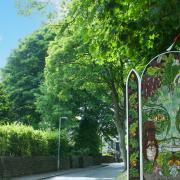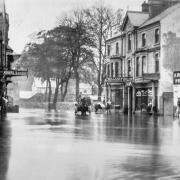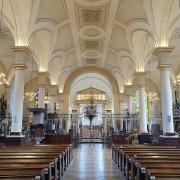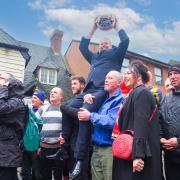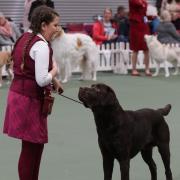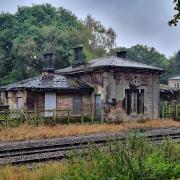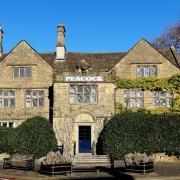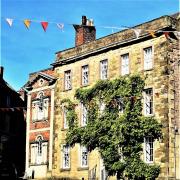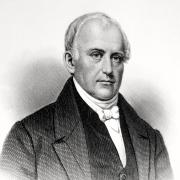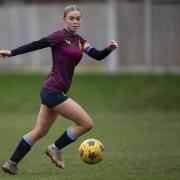During the period around Christmas and New Year, guising – the act of dressing up in outrageous costume and going around the local district performing a short seasonal play in return for a few pennies – was a formerly common practice.
In previous December editions, I have written about the hero vs villain combat plays and Derby Tup performances which were performed across Derbyshire.
As another twelve months have rolled around, it’s the turn of a third variant of traditional Derbyshire guising performances – The Poor Old Horse.
Like the Derby Tup, the Poor Old Horse comprises a short play with a song revolving around the symbolic death of an animal, involving the essential prop of a specially constructed animal head on a pole, operated by a performer beneath a cloak.
In 1981, folklore researcher Dave Bathe interviewed Jim Heath, aged 74, who grew up at New Whittington in the early years of the 20th century.
Bathe's notes record how the local butcher's shop at New Whittington run by his father (J. W. Heath) supplied ‘local lads with cows’ and sheep’s skulls and cleaned up horses’ skulls for use in a Christmas visiting custom’.
Heath described the arrival of the ‘Horse’: ‘You used to hear a knock at the door, […] these lads used to be singing and you’d open the door and there was this thing (horse’s head) snapping at you!’
Another source of horses’ heads was Clayton’s Knacker’s Yard, a tannery in Chesterfield: ‘It was a regular thing – he used to expect them at Christmas time... then they used to go to John Green’s timber yard at Whittington Hill and he used to fix the heads up for them’.
There is a recording of the horse making an appearing in Staveley in the mid-19th century. Folk dance and drama collector William J. Shipley spoke to an unnamed old lady in 1931, who remembered a visit as a young girl around 1865 – a frightening experience.

‘They came into my father’s yard (he wouldn't allow them in the house for they were so rough) and they set up a big horse, a wooden one - I believe it had wooden pegs for teeth - I was so terrified at their grotesque caps and faces’.
A tragic incident occurred in 1868-9. The Derbyshire Times of February 20 1869 reported on the discovery of the body of James Greenwood, a 31-year-old collier from Dronfield, in the River Derwent at Baslow Bridge the previous Saturday.
Greenwood was identified by his brother John who had last seen James the Wednesday after Christmas Day at Dronfield.
Greenwood’s guising troupe, which consisted of six other members, had performed the Old Horse at the Bull's Head Inn, Calver, on New Year's Day 1869.
The landlord, Isaac Bradwell, reported that the party arrived around eight o' clock and performed 'Ball'; at that point ‘they were not very sober’.
Fuelled by booze, internal tensions began to emerge, and eventually they became quarrelsome.
Greenwood announced he was going home and took off in the direction of Calver Bridge. It was the coroner's belief he had fallen over an embankment into the river at Calver Bridge and would have been unable to scramble to safety.
The newspaper reported Greenwood as having a ‘good character in his own neighbourhood, [and] has left a widow and two children to lament his untimely end’.
For perspective, it is worth highlighting Greenwood's native Dronfield is over ten miles from Calver.
The Poor Old Horse was still performed by a team from Dronfield up until the early 1970s, when folklorist Ruairidh Greig accompanied them on New Year’s Day performing at Dore, on the edge of Sheffield; writing the encounter up for the journal Lore and Language.

Shortly after the article’s publication in 1973 the team broke up, having become too elderly to continue and with no one else willing to take on the mantle.
The prop horse was subsequently confined to storage in the attic of a member of the Ralphs family, one of the former performers.
Twenty years later, members of the Old Dronfield Society retrieved it to perform the custom for fellow society members in the early 1990s – following which it mysteriously vanished; its current whereabouts are unknown.
The custom was not forgotten in Dronfield and a chance sighting of a horse's skull in an antique shop led to the idea of a revival.
First Art and Dronfield Heritage Trust put out an open call with a budget of £4,500, awarded to scriptwriters Rob Thomson and Eion Bentick, who worked with students from Henry Fanshawe school and interviewed elderly residents of local care homes to produce a short play performed on December 2 2016 as part of Dronfield’s annual Christmas lights switch-on.
‘What’s this all about then?’ demanded a red-faced gentleman in a too-tight tweed blazer stationed on the front row, brandishing an e-cig for emphasis.
‘It’s a play about a dead horse… it’s better than it sounds from that’, explained the lady in the next chair.
Recently I set up an Instagram account to document my Derbyshire folklore researches (@weirdderbyshire).
One benefit is that it has connected me with like-minded types I wouldn’t otherwise have come into contact with – one being Rob Barber, who was born in Sheffield but moved to Stoney Middleton as a child and has subsequently lived across most of the Hope Valley.

I was impressed to discover Rob had constructed his own horse prop based on the Poor Old Horse custom and I asked what inspired him to make it.
‘I was an avid reader of Ritual Animal Disguise, a book by R.C Cawte, which gives an in depth look at local folklore, custom and traditions, many of which involve dressing up as animals for ceremonies.
‘It's been hard to find an abundance of documentation about Poor Old Horse - the further south you go, the more information there is about such customs. It's rarer that this information is preserved and maintained in the north.
‘Customs like these become overlooked and many committed to the history books. It makes me wonder why, what happened to the horses? Why is this something missing from our culture as northerners?
‘This gave me a desire to breathe a little life back into poor old horse and create my own version, using the limited images available of the original as a guide.’
Rob subsequently contacted Ron Shuttleworth, author of Constructing a Hobby Animal.
Ron, now in his 90s, grew up in Hathersage and was delighted to see someone of a younger generation take an interest in his collection of folklore material, which was donated to Sheffield University Library in 2015.
Rob was given the skull of a Dartmoor pony which formed the basis of his prop. ‘After much cleaning and filling, I painted the skull shiny black as described in a 1973 Lore and Language article.
‘The eyes were made from silver birch, and marble oak galls and decorated white and devil red. The horse's mouth snaps open as part of the performance which has an operational wire mechanism and the pole is made from locally found ash wood.
‘The cape is a regular black hessian sack. The hobby horse is adorned with a pony bit and brasses and a few personal touches.’
I asked what his vision was for the Horse now he’d brought it into the world.
‘I'd love for this to be reintroduced into the community and for the tradition to be re-ignited. Perhaps it could be used in events, exhibited or used in education.
‘I find a lot of value in connecting to my roots and ancestors. I hope I can inspire others to do the same, whether through the Hobby Horse or other forgotten traditions.
‘While it's important we learn about other cultures and traditions, it's important to understand my own as well. We may think we know all there is to know about local history, but so much has been lost’.








